

Strategic bombing. The theoretical distinction between tactical and strategic air warfare was developed during the interbellum between the two world wars.
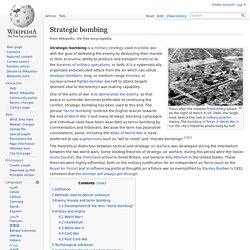
Some leading theorists of strategic air warfare, during this period were the Italian Giulio Douhet, the Trenchard school in Great Britain, and General Billy Mitchell in the United States. These theorists were highly influential, both on the military justification for an independent air force (such as the Royal Air Force) and in influencing political thoughts on a future war as exemplified by Stanley Baldwin's 1932 comment that the bomber will always get through.
Definition[edit] While the distinction between tactical, operational, and strategic bombing can be blurred, they are distinct methodologies generally used for different purposes. Strategic bombing is a methodology distinct from both tactical bombing and the use of strategic air assets in an operational capacity. Methods used to deliver ordnance[edit] Enemy morale and terror bombing[edit] Paratrooper. Pakistani Paratroopers Landing at Kalam Valley During Kalam Valley Annual Festival Paratroopers are military parachutists — military personnel trained in parachuting into an operation and usually functioning as part of an airborne force.

Military parachutists (troops) and parachutes were first used on a large scale during World War II for troop distribution and transportation. Paratroopers are often used to seize strategic objectives such as airfields or bridges. Overview[edit] U.S. This doctrine was first practically applied to warfare by the Italians and the Soviets. Company. A company, abbreviated as co., is a legal entity made up of an association of people, be they natural, legal, or a mixture of both, for carrying on a commercial or industrial enterprise.
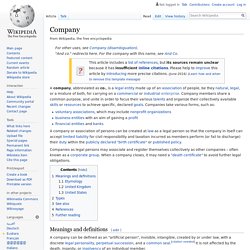
Company members share a common purpose, and unite in order to focus their various talents and organize their collectively available skills or resources to achieve specific, declared goals. Companies take various forms, such as: Companies as legal persons may associate and register themselves collectively as other companies – often known as a corporate group. Posttraumatic stress disorder. Most people who have experienced a traumatic event will not develop PTSD.[2] People who experience interpersonal trauma (for example rape or child abuse) are more likely to develop PTSD, as compared to people who experience non-assault based trauma, such as accidents and natural disasters.[7] About half of people develop PTSD following rape.[2] Children are less likely than adults to develop PTSD after trauma, especially if they are under 10 years of age.[8] Diagnosis is based on the presence of specific symptoms following a traumatic event.[2] Signs and symptoms Service members use art to relieve PTSD symptoms.

Symptoms of PTSD generally begin within the first 3 months after the inciting traumatic event, but may not begin until years later.[1][3] In the typical case, the individual with PTSD persistently avoids trauma-related thoughts and emotions, and discussion of the traumatic event, and may even have amnesia of the event. Associated medical conditions. Brigade. Brigades formed into divisions are usually infantry or armoured (sometimes referred to as combined arms brigades).
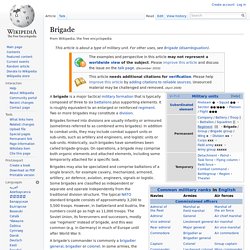
In addition to combat units, they may include combat support units or sub-units, such as artillery and engineers, and logistic units or sub-units. Historically, such brigades have sometimes been called brigade-groups. On operations, a brigade may comprise both organic elements and attached elements, including some temporarily attached for a specific task. Artillery battery. Land usage[edit] Historically the term "battery" referred to a cluster of cannon in action as a group, either in a temporary field position during a battle or at the siege of a fortress or a city.
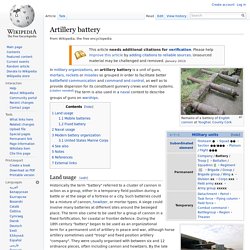
Such batteries could be a mixture of cannon, howitzer, or mortar types. A siege could involve many batteries at different sites around the besieged place. The term also came to be used for a group of cannon in a fixed fortification, for coastal or frontier defence. During the 18th century "battery" began to be used as an organizational term for a permanent unit of artillery in peace and war, although horse artillery sometimes used "troop" and fixed position artillery "company". Self Defense Test Ship. The Self Defense Test Ship (SDTS) is one of the assets of the US Navy.

It is a refurbished ship, operated by remote control, which is designed to support self-defense engineering, testing, and evaluation. Being unmanned, it avoids the safety constraints and other problems associated with manned ships. During typical operations, launched threats attack the ship and the combat or weapon system being tested responds to these threats, defending the ship.
The prearranged attack is in practice aimed at a decoy barge pulled 150 feet behind the SDTS in case of damage.[1] Troop. In some countries, like Italy, the company-level cavalry unit is called "Squadron".
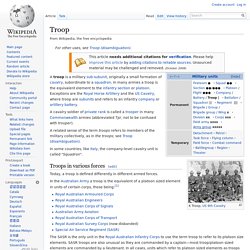
Troops in various forces[edit] Today, a troop is defined differently in different armed forces. In the Australian Army a troop is the equivalent of a platoon sized element in units of certain corps, those being:[1] The SASR is the only unit in the Royal Australian Infantry Corps to use the term troop to refer to its platoon size elements. Military police. Military police (MP) are police organizations connected with, or part of, the military of a state.
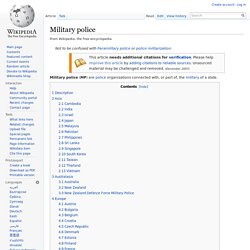
Description[edit] The word can have different meanings in different countries, and may refer to: The status of military police is usually prominently displayed on the helmet and/or on an armband, brassard, or arm or shoulder flash. In the Second World War, the military police of the German Army still used a metal gorget as an emblem. Naval police are sometimes called "masters-at-arms". Parachute. Drogue chutes are used to aid horizontal deceleration of a vehicle (a fixed-wing aircraft, or a drag racer), or to provide stability (certain types of light aircraft in distress;[1][2] tandem free-fall).
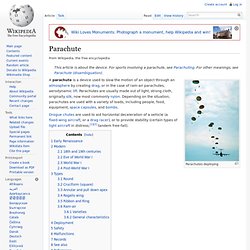
Early Renaissance[edit] The oldest known depiction of a parachute, by an anonymous author (Italy, 1470s) The earliest evidence for the parachute dates back to the Renaissance period.[3] The oldest parachute design appears in an anonymous manuscript from 1470s Renaissance Italy (British Museum Add. United States Marine Corps Scout Sniper.
A United States Marine Corps Scout Sniper (MOS 0317, formerly 8541) is a secondary MOS (Military Occupational Specialty) designator of U.S. Marine Corps infantrymen and reconnaissance Marines that have graduated from a U.S. Marine Corps Scout Sniper School. Panzer division. A panzer division was a combined arms formation, having both tanks (German Panzerkampfwagen, "armored fighting vehicle", usually shortened to "Panzer") and infantry as organic components, along with the usual assets of artillery, anti-aircraft, signals, etc. However, the proportions of the components of a panzer division changed over time. Pre-war development[edit] Most other armies of the era organized their tanks into "tank brigades" requiring additional infantry and artillery support.
Fireteam. Fireteams are the second smallest organized unit in the militaries that use it; the smallest being three or fewer soldier support or specialist teams (such as anti-tank teams, machine gun teams, mortar teams, sniper teams, EOD teams, or military working dog teams) that are designed to operate independently. Fireteams are the primary unit upon which modern infantry organization is based in the British Army, Royal Air Force Regiment, Royal Marines, United States Army, United States Marine Corps, United States Air Force Security Forces, Canadian Forces, and Australian Army. Concept[edit] The concept of the fireteam is based on the need for tactical flexibility in infantry operations. A fireteam is capable of autonomous operations as part of a larger unit.
These requirements have led to successful use of the fireteam concept by more professional militaries. Glider infantry. The Glider Badge: Worn by U.S. Army airborne soldiers who rode gliders instead of parachuting into combat. Glider infantry (also referred to as Airlanding infantry esp. in British usage) was a type of airborne infantry in which soldiers and their equipment were inserted into enemy controlled territory via military glider rather than parachute. Section. From Wikipedia, the free encyclopedia Section may refer to: Writing[edit] Platoon. Company. Amphibious warfare.
Infantry. Infantry is the branch of a military force that fights on foot. As the troops who are intended to engage, fight, and defeat the enemy in face-to-face combat, they bear the brunt of warfare and typically suffer the greatest number of casualties. Historically, as the oldest branch of the combat arms, the infantry are the tip of the spear of a modern army, and continually undergo training that is more physically stressful and psychologically demanding than that of any other branch of the combat arms. Infantry can enter and maneuver in terrain that is inaccessible to military vehicles and employ crew-served infantry support weapons that provide greater and more sustained firepower.
Strategic bombing. The theoretical distinction between tactical and strategic air warfare was developed during the interbellum between the two world wars. Some leading theorists of strategic air warfare, during this period were the Italian Giulio Douhet, the Trenchard school in Great Britain, and General Billy Mitchell in the United States. These theorists were highly influential, both on the military justification for an independent air force (such as the Royal Air Force) and in influencing political thoughts on a future war as exemplified by Stanley Baldwin's 1932 comment that the bomber will always get through.
Light infantry. Traditionally light infantry (or skirmishers) were soldiers whose job was to provide a skirmishing screen ahead of the main body of infantry, harassing and delaying the enemy advance. Marine Air-Ground Task Force. Special operations. Special operations (S.O.) are military operations that are considered "special" (that is, unconventional), usually carried out by dedicated special forces units. Special operations are typically performed independently or in conjunction with conventional military operations. Mechanized infantry. U.S. Motorised infantry. Cold War era (1975) Snow Trac on patrol in Norway In NATO and most other western countries, motorized infantry is infantry that is transported by trucks or other un-protected motor vehicles. Armoured warfare. Close air support. Opposing force.
Sealift. Task Force 88 (anti-terrorist unit) Motorised infantry. Capital ship. Aerial warfare. Ship-To-Objective Maneuver. Mechanized infantry. Formation reconnaissance regiment. Armoured reconnaissance. Close air support. Military sociology. Regimental Police. Guerrilla warfare. AirLand Battle. Commando. Armoured cavalry. Cavalry. Line regiment. Formation reconnaissance regiment.
Mortar (weapon) Jungle warfare. Military engineering. Combat air patrol. Military reserve force. General-purpose machine gun. Hull classification symbol. Urban warfare. Urban warfare. Military transport aircraft. Combat engineer. Staff college. Small-waterplane-area twin hull. Paratrooper. Regimental combat team.